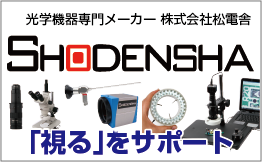Visual inspection from microscope to microscope
In many cases, microscopic inspections are performed on inspection lines. Inspections using microscopes can be very tiring, and this places a commensurate burden on the inspector. For this reason, many people want to replace microscopes with microscopes.
However, there are many different types of microscopes, and if the most appropriate one is not selected, it may cause unnecessary strain.
There are three points to keep in mind when transitioning from a microscope to a microscope.
However, there are many different types of microscopes, and if the most appropriate one is not selected, it may cause unnecessary strain.
There are three points to keep in mind when transitioning from a microscope to a microscope.
3 Important Points in Microscope Selection
① Selecting a model with a high frame rate
Microscopes are displayed on a PC or monitor as video images.
If the frame rate is low, the projected image does not move smoothly, which causes unnecessary stress.
The frame rate is expressed as a numerical value, and the value that people do not feel uncomfortable is about 50 to 60 fps.
If the frame rate drops below 30 fps, the feeling of discomfort becomes noticeable.
The frame rate of the type that can be connected to a PC is often low due to the problem of USB communication speed.
Therefore, we recommend that you choose a type directly connected to the monitor.
If the frame rate is low, the projected image does not move smoothly, which causes unnecessary stress.
The frame rate is expressed as a numerical value, and the value that people do not feel uncomfortable is about 50 to 60 fps.
If the frame rate drops below 30 fps, the feeling of discomfort becomes noticeable.
The frame rate of the type that can be connected to a PC is often low due to the problem of USB communication speed.
Therefore, we recommend that you choose a type directly connected to the monitor.
② Select a model with good color reproduction
The way the microscope sees depends on the camera used for the microscope.
Therefore, there are some that reproduce colors beautifully and some that reproduce colors less beautifully.
When colors are not reproduced beautifully, the human brain feels a sense of discomfort, which causes stress.
If a red object looks a little bit orange, it is uncomfortable and stressful.
If you choose a full HD camera, the color reproduction is relatively high, so you can get a clear image.
Therefore, there are some that reproduce colors beautifully and some that reproduce colors less beautifully.
When colors are not reproduced beautifully, the human brain feels a sense of discomfort, which causes stress.
If a red object looks a little bit orange, it is uncomfortable and stressful.
If you choose a full HD camera, the color reproduction is relatively high, so you can get a clear image.
③ Select a model with a wide dynamic range
The term “dynamic range” may not be familiar to you, but to explain it simply, when a bright object and a dark object are simultaneously projected, matching the brightness to one of them may cause the other one to be washed out or blacked out. To eliminate this phenomenon, a camera with a wide dynamic range is necessary. Dynamic range is a status that a camera has, but it also varies from camera to camera. Compared to general-purpose cameras, the human eye is very good and has a very wide dynamic range.
A large part of the discomfort between what we see with the human eye and what we see through a camera is often due to the difference in dynamic range.
There are some models that have a wide dynamic range, so I think it is best to choose such a model.
A large part of the discomfort between what we see with the human eye and what we see through a camera is often due to the difference in dynamic range.
There are some models that have a wide dynamic range, so I think it is best to choose such a model.
Recommended models
We have models that meet all three of the above requirements.
Microscope full HD
Frame rate = 60 fps
Color reproduction = Very clear due to full high definition resolution
Dynamic range = Wide with HDR (High Dynamic Range) function
We have a demo unit available, so please try it out for yourself.
Microscope full HD
Frame rate = 60 fps
Color reproduction = Very clear due to full high definition resolution
Dynamic range = Wide with HDR (High Dynamic Range) function
We have a demo unit available, so please try it out for yourself.




